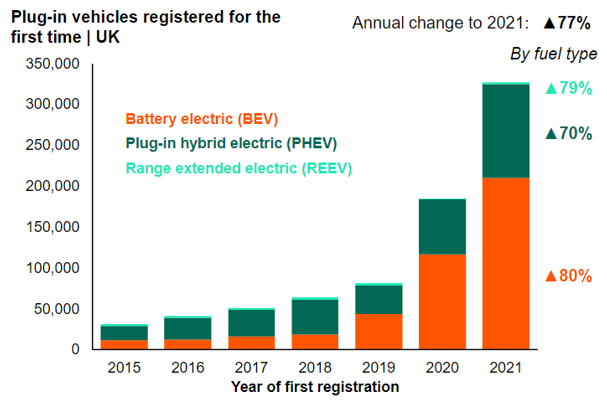Hybrid Car Guide

What is a hybrid car?
A hybrid car typically combines an electric motor with a conventional engine (usually petrol or diesel). The two work together to power the car making them more environmentally friendly than traditional fuel-powered cars, as they consume less fuel and emit less CO2.
Why choose a Hybrid?
Hybrid vehicles are becoming more and more popular in the UK as we head towards becoming more environmentally friendly. The shift towards greener vehicles has also been spurred on by the government’s 2020 announcement that the sale of new petrol and diesel cars will be banned from 2030.
How many are there in the UK
The number of hybrid and other ultra-low emission vehicles (ULEVs) are becoming more popular, with new registrations in 2021 being:
- Hybrid electric vehicle (HEV) cars 264,000 (16% of registrations) increasing 57% from 2020
- Battery electric vehicle (BEV) cars 190,000 (11% of Registrations) increasing 80% from 2020
- Plugin hybrid electric vehicle (PHEV) cars 114,000 (7% of registrations) increasing 70% from 2020
according to the Department for Transport annual Vehicle Licensing Statistics.
With 2022 adding further new registrations of ULEV’s to the roads there is now estimated to be over 500,000 plugin cars in the UK.

(Vehicle Licensing Stats, 2021)
What's the difference between hybrid and electric cars?
The main difference between a hybrid car and an electric car is that while electric cars are fully powered by electricity, hybrids combine an electric motor with a conventional fuel engine. This means that an electric car is a completely non-polluting ultra-low emission vehicle, while hybrids still produce some emissions. However with range anxiety still a concern for fully electric cars due to the infancy of the charging network in the UK, having the mix of fuel & electric could be the right choice until there are more public recharging options.
Electric cars must be plugged in in order to recharge their batteries, whereas most hybrid cars recharge their batteries as they drive, using energy produced by the fuel engine during braking.
How do hybrid cars work?
What differences are there between different hybrid engines? Each contains an electric motor and a fuel engine, and each works in a diverse way:
1. Full hybrids
Full hybrid is the term used to describe a car where the wheels can be powered by the engine, the electric motor, or with both power sources working together. Full hybrid cars (also known as parallel hybrid cars) use the electric motor at low speeds and the fuel engine at higher speeds and when the electric charge is low. These hybrid cars do not need to be plugged in as the battery is charged by the fuel engine when it’s low.
2. Mild hybrids
Mild hybrid cars have an electric motor and larger battery in addition to the gas engine. These power the electrical systems in your car allowing the engine to use more of its energy while actually driving. Mild hybrid cars can’t drive using the electric motor, however some can boost the power when accelerating. This type of hybrid car does not need to be plugged in to charge, the battery is charged when the car coasts or brakes.
3. Plug-in hybrids
Plug-in hybrid cars have a larger battery that can be charged at home through household sockets or at one of the thousands of free charging stations around the UK. The larger batteries can drive further on the electric engine alone before the fuel engine engages to help power the car.
The benefits of hybrid cars
So, what are the benefits of hybrid vehicles compared to conventional fuel vehicles?
They're more environmentally friendly
One of the biggest advantages of hybrid cars is that they have lower fuel consumption than a conventional car, meaning fewer emissions. This makes them greener, cleaner and better for the environment when driven efficiently.
They recharge as you drive
A conventional hybrid has regenerative braking, which means the battery recharges as you drive. This means that you don’t have to worry about stopping to charge it up on longer journeys - which you could have to do with an electric car.
They offer road tax benefits
Alternative fuel cars, including hybrid cars, are cheaper to tax than conventional cars with petrol and diesel engines.For cars registered between 1st March 2001 & 31st March 2017:
In this time period your car tax would be based purely on the CO2 emissions.
For cars registered on or after 1st April 2017:
The first time you register a car the tax you pay is based on the CO2 emissions it produces. From the 2nd year you would pay £155 for 12 months based on a single payment.
You can check your cars C02 emission rate on its logbook or from this government website.
Bear in mind you will also pay an additional cost of £355 on your car tax for 5 years (from the 2nd year) if the vehicle list price is £40,000 or over at registration.
How do you charge plug-in hybrid cars?
There are a few ways to charge a hybrid or electric car:
Charging your car at home
While you can charge a hybrid car through your domestic sockets, the best option is to get an electric vehicle charger installed. These offer a faster charge and are weatherproof.
Charging your car at work
Many firms have taken up the Government Workplace Charging Scheme and have installed dedicated parking at their buildings for charging hybrid and electric vehicles.
Charging your car on the road
Public charging points are appearing in more places across the UK. They can be found in some public car parks, as well as some shopping areas, petrol stations and motorway services.
Through a grant scheme from the Office for Low Emission Vehicles and Office for Zero-Emission Vehicles, some vehicles may entitle you to funding towards an electric vehicle charge point at your home. Visit the Government website for further details.
Our electric car charging page answers more questions about charging your plugin PHEV or BEV
References:
https://www.gov.uk/government/news/government-takes-historic-step-towards-net-zero-with-end-of-sale-of-new-petrol-and-diesel-cars-by-2030
https://assets.publishing.service.gov.uk/government/uploads/system/uploads/image_data/file/151195/05-image-5.SVG
https://www.zap-map.com/live/
https://www.gov.uk/vehicle-tax-rate-tables
https://www.gov.uk/co2-and-vehicle-tax-tools
https://www.gov.uk/government/collections/government-grants-for-low-emission-vehicles#workplace-charging-scheme
You might also be interested in
Understanding your car cover and when it applies
Check out our video for top car cover tips.
FCA changes to insurance and how they may affect your premium
The Financial Conduct Authority (FCA) – an insurance industry regulator – recently introduced new regulation to insurance pricing to take effect on 1 January 2022.

